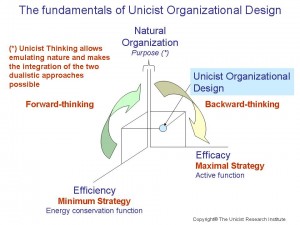Changing administrative systems into adaptive systems is a big change that needs to be managed as such. The unicist ontology discovered for organizational design allowed defining the structure of the organizational process to be used when a business starts or a big change is being implemented.
 By just implementing the first step of the taxonomy of Unicist Organizational Design you will know how big the change is:
By just implementing the first step of the taxonomy of Unicist Organizational Design you will know how big the change is:
Taxonomy of the Organizational Process
1) Japanese Park – Pilot test: The first step to define the limits of the environment is letting things work in a natural way. This demonstrates the functionality of the context and allows defining the possibilities of what needs to be designed. When the values shown by the environment are extremely far away from what is needed the organizational process cannot be implemented.
2) The benefits of the parts involved in a working process need to be clarified. Both the organizational benefit and the personal benefits need to be approached in a “hypothetical” way. This step establishes the expectations of the parts involved.
3) The responsibilities of the parts need to be defined within the limits of the capacity of the individuals to assume them. When it is necessary to develop maximal strategies one must consider the capacity of managing risks, uncertainty and the frustrations of the participants. The design has to be based on the capacity of individuals to assume the responsibility.
4) The methodology of the work defines the logic that needs to be used. The methodology needs to be known before individuals are able to generate benefits for the organization and themselves. Methodologies need to be adequate to the level of the participants.
5) Confirming the benefits implies that the individuals know what benefits need to be produced for the organization and for them. The Minimum Strategy can only be designed after this is transparent.
6) Approach the possibility of minimizing costs to ensure the minimum strategy. The objective of this step is to confirm that the costs are within the limits of a minimum strategy.
7) Define the use value of the organization in its unit without considering the different subsystems or individuals that integrate it. It has to be defined what it is that the organization needs to achieve and how this objective will be fulfilled.
8) Define the methods to be used in the organization and how the performance management of the use of the methods will be developed. Methods need to be defined including the quality assurance and / or quality control system.
9) Confirm the cost of the solution that is being designed. This implies redefining alternatives that allow cost reductions that do not modify the structure of the organization. It necessarily drives to redefining the previously defined stages seeking for cost reductions.
10) Pilot test making. Both destructive and non-destructive pilot tests need to be used. The first test has to be the destructive test in order to be aware of the limits of the validity of the solution.
Japanese Park – The first step
By just observing how the system is spontaneously managed you will know the distance between what happens today and the necessary functionality. This distance defines the size of the change to be implemented.
If the distance is small, just continue with the steps of the organizational design. If the distance is big, a valid change management technology is needed.
If a big change technology is needed but disregarded, the possibility of change is inhibited.
Learn more: http://www.unicist.org/papers/unicist_organizational_design_en.pdf
